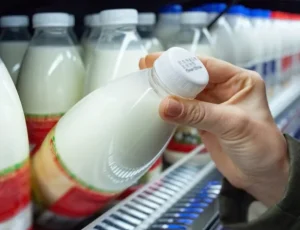How Misunderstood Expiration Dates Contribute to America’s Food Waste Problem

As some of you may know, my day job is that of a professional culinarian and executive chef in a kitchen that feeds about 150 folks three meals a day, every day of the year. And as such, I’m tasked in part with limiting food waste in order to maintain my annual budget. A budget which is always too small.
A few days ago I saw one of my cooks about to toss an unopened gallon of milk into the trash. “STOP! I exclaimed. “What’s wrong with the milk?”
“It’s out of date, Chef. We can’t use it.”
“Please, bring it to me.” I then opened the jug and asked, “How does it smell? Sour? Is it curdled? Does it taste sour?”
“No, but it’s out of date, so by law we can’t serve it.”
“By whose law are you talking about? Please, pour the milk in the pitcher and serve it. If any of our guests complain about the taste or gets sick, I’ll take full responsibility.”
Later that afternoon, I called a kitchen staff meeting to explain food expiration dates—how they got started and what they really mean.
Sell-by dates actually got their start in Britain’s famous Marks & Spencer’s department store chain some 50 years ago as part of their in-house quality control system. Then in 1972 they began putting dates on their line of baked goods as a way to boost sagging sales with their quality-minded patrons. Their marketing ploy seemed to work. At least for a time.
 Food date labeling in the U.S. began to appear sometime after WWII, as a way for manufactures to assist supermarkets in rotating their stock. For a decade or so, those date codes were secretive with only the grocers able to decipher them. However, as the public buying habits included more and more processed and prepackaged foods, so grew consumers desire to understand these codes as a way of assuring themselves that the products bought were the freshest possible.
Food date labeling in the U.S. began to appear sometime after WWII, as a way for manufactures to assist supermarkets in rotating their stock. For a decade or so, those date codes were secretive with only the grocers able to decipher them. However, as the public buying habits included more and more processed and prepackaged foods, so grew consumers desire to understand these codes as a way of assuring themselves that the products bought were the freshest possible.
So, in the mid-seventy’s food processors, relented to shopper demands that those date be written in a simple, easy to understand way. This led to what is now known as “open date” labeling, which clearly shows the month, day, and year goods are produced. Manufacturers were also quick to realize open date labeling not only helped provided consumers’ confidence in their products, it also became an important marketing tool for attracting new customers. Unfortunately, only a handful of consumers, if any, really understood the what those “Sell By” dates meant. Most interpreted it as a “do not use after date,” misconception that manufacturers were more than happy to accept since it meant more sales.
Even the federal government's attempt to enact laws setting national criteria for date labels resulted in failure, and to make matters worse they passed the burden on to state legislatures, whose attempts were equally as confusing. One state may not require labels at all, while another may mandate milk to have a 21- day freshness threshold, while another may set the date at 14 days. Still other states left it up to the manufacturers themselves to establish the expiration dates for their products—talk about letting the fox into the henhouse.
And if those scenarios are not confusing enough, add to them the way food date labels are worded. Some say “sell by,” another may say “best by,” and yet another, “best if used before.” How is one supposed to interpret the meaning of those labels? Unfortunately, a huge majority of today’s consumers believe that any product past those dates is unusable and must be trashed, regardless on how the label is worded.
 That brings us to this country’s food waste problem. Did you know that 40% of all food produced in the U.S. is wasted and ends up in the landfill, although much of it is perfectly fine to eat? And that American families toss about 290 pounds, or an average of $1,825 worth of food, into the garbage bin each and every year? On top of that, state-imposed regulations make it difficult, even impossible, for out-of-date food to be donated to help feed the some 40 million people in this country living with hunger daily. And if that were not bad enough, environmental studies show that 25 percent of the fresh water in this company is used to produce that trashed food.
That brings us to this country’s food waste problem. Did you know that 40% of all food produced in the U.S. is wasted and ends up in the landfill, although much of it is perfectly fine to eat? And that American families toss about 290 pounds, or an average of $1,825 worth of food, into the garbage bin each and every year? On top of that, state-imposed regulations make it difficult, even impossible, for out-of-date food to be donated to help feed the some 40 million people in this country living with hunger daily. And if that were not bad enough, environmental studies show that 25 percent of the fresh water in this company is used to produce that trashed food.
Truth is there is no scientific evidence to support trashing food based solely on the “expired” date. The freshness date on foods almost never corresponds to whether not you’ll get sick if it's eaten out of date. Foods that are handled properly can usually be consumed days, sometimes weeks, after the date printed on the label. Even milk.
There are only three things you need to know about food labels in this country: With the exception of baby formula, the federal government has never set expiration dates on our foods, there is no standardization in expiration dates set by state governments, and finally almost none of the dates on our foods has anything at all to do with whether it’s safe to consume them. In fact, pretty much any food we purchase will last anywhere from a week or so to years longer than the dates printed on the package, if stored and handled responsibly.
I’m not implying that our food manufacturers are purposely trying to deceive us with the dates they put on their products. In their minds they may simply be protecting their brands by establishing dates that prompt us to eat their foods while at the peak of flavor. On the other hand, processors are not breaking their backs to let us know how broken the current system really is.
 Consumers in this country are certainly not without fault. We have gotten into the habit of expecting our governments, both federal and state, to protect us, to think for us instead of using our own minds and senses to determine what is or isn’t in our best interests. This is especially true when it comes to the food we eat. It’s time that we put an end to this “follow like a sheep” mindset and rely instead on how food looks, smells, and tastes before trashing it.
Consumers in this country are certainly not without fault. We have gotten into the habit of expecting our governments, both federal and state, to protect us, to think for us instead of using our own minds and senses to determine what is or isn’t in our best interests. This is especially true when it comes to the food we eat. It’s time that we put an end to this “follow like a sheep” mindset and rely instead on how food looks, smells, and tastes before trashing it.
And although Congress has thus far shown very little interest in helping to resolve this plight, it is certainly an area that needs their full attention if consumers are going to continue to rely on date labels. A well thought out nationwide labeling system could save thousands of pounds of food and impact our economy by some $2 billion annually. But even the best standardized system would fail unless supported with an all-out national educational effort directed towards changing consumer misconceptions.
And until we, as consumers, apply unrelenting demand and pressure on Congress to work together with food manufactures to set sensible national labeling standards, nothing will change.




